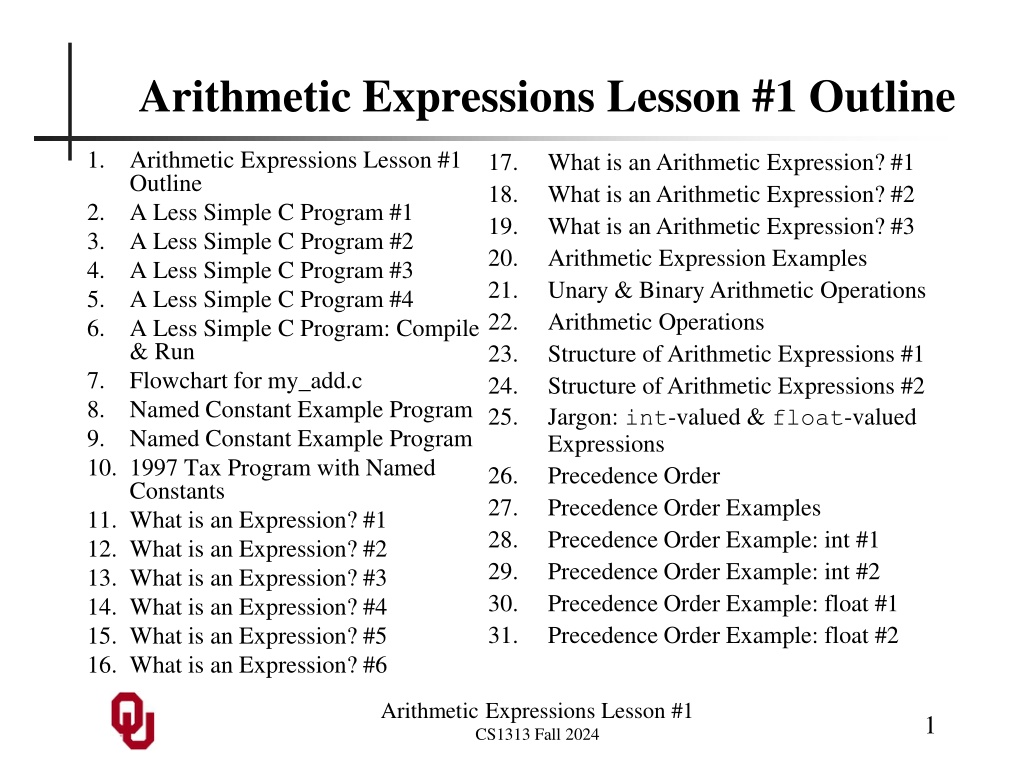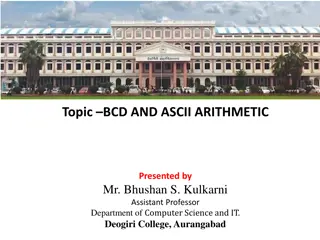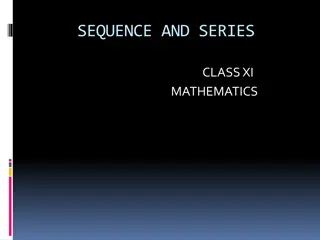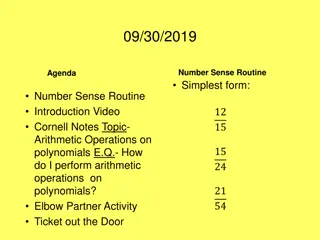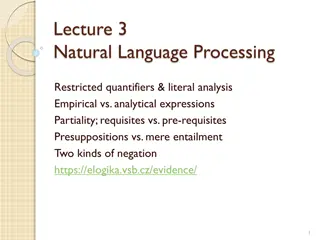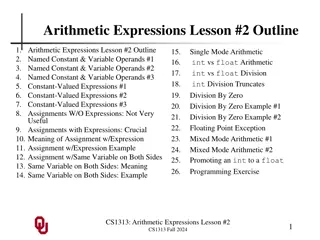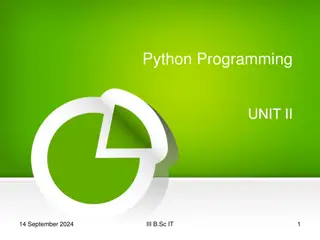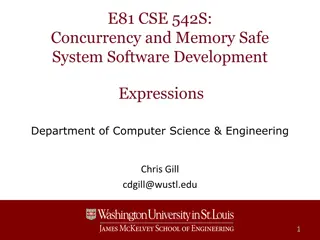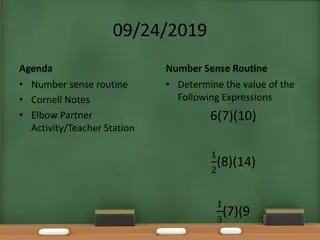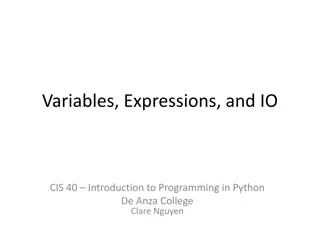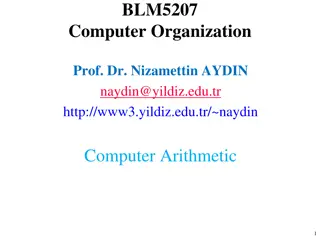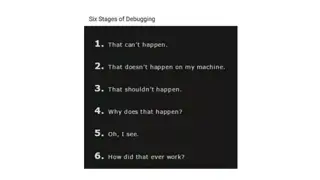Understanding Arithmetic Expressions in C Programming
This lesson outlines the basics of arithmetic expressions in C programming, focusing on how to perform unary and binary arithmetic operations. It covers the structure of arithmetic expressions, precedence order, and examples to illustrate these concepts. The provided C program, 'my_add,' demonstrates how to add two integers and output the result. Additionally, it explains the calculation, input, and output sections of the program.
Uploaded on Sep 21, 2024 | 0 Views
Download Presentation

Please find below an Image/Link to download the presentation.
The content on the website is provided AS IS for your information and personal use only. It may not be sold, licensed, or shared on other websites without obtaining consent from the author. Download presentation by click this link. If you encounter any issues during the download, it is possible that the publisher has removed the file from their server.
E N D
Presentation Transcript
Arithmetic Expressions Lesson #1 Outline 1. Arithmetic Expressions Lesson #1 Outline A Less Simple C Program #1 A Less Simple C Program #2 A Less Simple C Program #3 A Less Simple C Program #4 A Less Simple C Program: Compile & Run Flowchart for my_add.c Named Constant Example Program Named Constant Example Program 10. 1997 Tax Program with Named Constants 11. What is an Expression? #1 12. What is an Expression? #2 13. What is an Expression? #3 14. What is an Expression? #4 15. What is an Expression? #5 16. What is an Expression? #6 17. 18. 19. 20. 21. 22. 23. 24. 25. What is an Arithmetic Expression? #1 What is an Arithmetic Expression? #2 What is an Arithmetic Expression? #3 Arithmetic Expression Examples Unary & Binary Arithmetic Operations Arithmetic Operations Structure of Arithmetic Expressions #1 Structure of Arithmetic Expressions #2 Jargon: int-valued & float-valued Expressions Precedence Order Precedence Order Examples Precedence Order Example: int #1 Precedence Order Example: int #2 Precedence Order Example: float #1 Precedence Order Example: float #2 2. 3. 4. 5. 6. 7. 8. 9. 26. 27. 28. 29. 30. 31. Arithmetic Expressions Lesson #1 CS1313 Fall 2024 1
A Less Simple C Program #1 /* ************************************************ *** Program: my_add *** *** Author: Henry Neeman (hneeman@ou.edu) *** *** Course: CS 1313 010 Fall 2024 *** *** Lab: Sec 014 Fridays 1:00pm *** *** Description: Input two integers, compute *** *** their sum and output the result. *** ************************************************ */ #include <stdio.h> int main () { /* main */ /* *************************** *** Declaration Section *** *************************** * ***************************** * Named Constant Subsection * ***************************** */ const int program_success_code = 0; /* ***************************** * Local Variable Subsection * ***************************** * * addend: the addend value that the user inputs. * augend: the augend value that the user inputs. * sum: the sum of the addend and the augend, * which is output. */ int addend, augend, sum; Continued on the next slide. Arithmetic Expressions Lesson #1 CS1313 Fall 2024 2
A Less Simple C Program #2 /* ************************* *** Execution Section *** ************************* * *********************** * Greeting Subsection * *********************** * * Tell the user what the program does. */ printf("I'll add a pair of integers.\n"); /* ******************** * Input subsection * ******************** * * Prompt the user to input the addend & augend. */ printf("What pair of integers do you want to add?\n"); /* * Input the integers to be added. */ scanf("%d %d", &addend, &augend); Continued on the next slide. Arithmetic Expressions Lesson #1 CS1313 Fall 2024 3
A Less Simple C Program #3 /* ************************** * Calculation Subsection * ************************** * * Calculate the sum. */ sum = addend + augend; /* ********************* * Output Subsection * ********************* * * Output the sum. */ printf("The sum of %d and %d is %d.\n", addend, augend, sum); return program_success_code; } /* main */ The statement as a whole is an assignment statement. The stuff to the right of the single equals sign is an arithmetic expression. Arithmetic Expressions Lesson #1 CS1313 Fall 2024 4
A Less Simple C Program #4 #include <stdio.h> int main () { /* main */ const int program_success_code = 0; int addend, augend, sum; printf("I'll add a pair of integers.\n"); printf("What pair of integers do you want to add?\n"); scanf("%d %d", &addend, &augend); sum = addend + augend; printf("The sum of %d and %d is %d.\n", addend, augend, sum); return program_success_code; } /* main */ The statement as a whole is an assignment statement. The stuff to the right of the single equals sign is an arithmetic expression. Arithmetic Expressions Lesson #1 CS1313 Fall 2024 5
A Less Simple C Program: Compile & Run % gcc -o my_add my_add.c % my_add I'll add a pair of integers. What pair of integers do you want to add? 5 7 The sum of 5 and 7 is 12. % my_add I'll add a pair of integers. What two integers do you want to add? 1593 09832 The sum of 1593 and 9832 is 11425. Arithmetic Expressions Lesson #1 CS1313 Fall 2024 6
Flowchart for my_add.c A rectangle denotes an operation other than I/O or branching (for example, calculation). Arithmetic Expressions Lesson #1 CS1313 Fall 2024 7
Named Constant Example Program % cat circlecalc.c #include <stdio.h> int main () { /* main */ const float pi = 3.1415926; const float diameter_factor = 2.0; const int program_success_code = 0; float radius, circumference, area; printf("I'm going to calculate a circle's\n"); printf(" circumference and area.\n"); printf("What's the radius of the circle?\n"); scanf("%f", &radius); circumference = pi * radius * diameter_factor; area = pi * radius * radius; printf("The circumference is %f\n", circumference); printf(" and the area is %f.\n", area); return program_success_code; } /* main */ % gcc -o circlecalc circlecalc.c % circlecalc I'm going to calculate a circle's circumference and area. What's the radius of the circle? 5 The circumference is 31.415924 and the area is 78.539810. Arithmetic Expressions Lesson #1 CS1313 Fall 2024 8
Named Constant Example Program % cat circlecalc.c #include <stdio.h> int main () { /* main */ const float pi = 3.1415926; const float diameter_factor = 2.0; const int program_success_code = 0; float radius, circumference, area; printf("I'm going to calculate a circle's\n"); printf(" circumference and area.\n"); printf("What's the radius of the circle?\n"); scanf("%f", &radius); circumference = pi * radius * diameter_factor; area = pi * radius * radius; printf("The circumference is %f\n", circumference); printf(" and the area is %f.\n", area); return program_success_code; } /* main */ % gcc -o circlecalc circlecalc.c % circlecalc I'm going to calculate a circle's circumference and area. What's the radius of the circle? 5 The circumference is 31.415924 and the area is 78.539810. Arithmetic Expressions Lesson #1 CS1313 Fall 2024 9
1997 Tax Program with Named Constants % cat tax1997_named.c #include <stdio.h> int main () { /* main */ const float standard_deduction = 4150.0; const float single_exemption = 2650.0; const float tax_rate = 0.15; const int tax_year = 1997; const int program_success_code = 0; float income, tax; printf("I'm going to calculate the federal income tax\n"); printf(" on your %d income.\n", tax_year); printf("What was your %d income in dollars?\n", tax_year); scanf("%f", &income); tax = (income - (standard_deduction + single_exemption)) * tax_rate; printf("The %d federal income tax on $%2.2f\n", tax_year, income); printf(" was $%2.2f.\n", tax); return program_success_code; } /* main */ % gcc -o tax1997_named tax1997_named.c % tax1997_named I'm going to calculate the federal income tax on your 1997 income. What was your 1997 income in dollars? 20000 The 1997 federal income tax on $20000.00 was $1980.00. Arithmetic Expressions Lesson #1 CS1313 Fall 2024 10
What is an Expression? #1 a + b - c * d / e % f (398 + g) * 5981 / 15 % h In programming, an expressionis a combination of: Operands Operators Parentheses: ( ) Not surprisingly, an expression in a program can look very much like an expression in math (though not necessarily identical). This is on purpose. NOTE: In C, the only characters you can use for parenthesizing are actual parentheses (unlike in math, where you can also use square brackets and curly braces.) Arithmetic Expressions Lesson #1 CS1313 Fall 2024 11
What is an Expression? #2 a + b - c * d / e % f (398 + g) * 5981 / 15 % h In programming, an expressionis a combination of: Operands, such as: Literal constants Named constants Variables Function invocations(which we ll discuss later) Operators Parentheses: ( ) Arithmetic Expressions Lesson #1 CS1313 Fall 2024 12
What is an Expression? #3 a + b - c * d / e % f (398 + g) * 5981 / 15 % h In programming, an expressionis a combination of: Operands Operators, such as: Arithmetic Operators Relational Operators Logical Operators Parentheses: ( ) Arithmetic Expressions Lesson #1 CS1313 Fall 2024 13
What is an Expression? #4 a + b - c * d / e % f (398 + g) * 5981 / 15 % h In programming, an expressionis a combination of: Operands Operators, such as: Arithmetic Operators Addition: + Subtraction: - Multiplication: * Division: / Modulus (remainder): % (only for int operands) Relational Operators Logical Operators Parentheses: ( ) Arithmetic Expressions Lesson #1 CS1313 Fall 2024 14
What is an Expression? #5 a + b - c * d / e % f (398 + g) * 5981 / 15 % h In programming, an expressionis a combination of: Operands Operators, such as: Arithmetic Operators Relational Operators Is Equal: == Not Equal: != Less Than: < Less Than or Equal To: <= Greater Than: > Greater Than or Equal To: >= Logical Operators Parentheses: ( ) Arithmetic Expressions Lesson #1 CS1313 Fall 2024 15
What is an Expression? #6 a + b - c * d / e % f (398 + g) * 5981 / 15 % h In programming, an expressionis a combination of: Operands Operators, such as: Arithmetic Operators Relational Operators Logical Operators Negation (NOT): ! Conjunction (AND): && Disjunction (OR): || Parentheses: ( ) We ll learn about these later. Arithmetic Expressions Lesson #1 CS1313 Fall 2024 16
What is an Arithmetic Expression? #1 An arithmetic expression (also called a numeric expression) is a combination of: Numeric operands Arithmetic Operators Parentheses: ( ) Arithmetic Expressions Lesson #1 CS1313 Fall 2024 17
What is an Arithmetic Expression? #2 An arithmetic expression (also called a numeric expression) is a combination of: Numeric operands, such as: int & float literal constants (BAD BAD BAD) int & float named constants (GOOD) int & float variables int-valued & float-valued function invocations Arithmetic Operators Parentheses: ( ) Arithmetic Expressions Lesson #1 CS1313 Fall 2024 18
What is an Arithmetic Expression? #3 An arithmetic expression (also called a numeric expression) is a combination of: Numeric operands Arithmetic Operators, such as: Identity: + Negation: - Addition: + Subtraction: - Multiplication: * Division: / Modulus (remainder): % (only for int operands) Parentheses: ( ) Arithmetic Expressions Lesson #1 CS1313 Fall 2024 19
Arithmetic Expression Examples x +x -x x + y x - y x * y x / y x % y x + y - (z % 22) * 7 / cos(theta) Arithmetic Expressions Lesson #1 CS1313 Fall 2024 20
Unary & Binary Arithmetic Operations Arithmetic operations come in two varieties: unaryand binary. A unary operation is an operation that has only one operand. For example: -x Here, the operand is x, the operator is the minus sign, and the operation is negation. A binary operation uses two operands. For example: y + z Here, the operands are y and z, the operator is the plus sign, and the operation is addition. Arithmetic Expressions Lesson #1 CS1313 Fall 2024 21
Arithmetic Operations Operation Kind Oper- ator + none - + - * Usage Value Value of x Value of x Additive inverse of x x + y Sum of x and y x y Difference between x and y x * y Product of x times y (i.e., x.y) x / y Quotient of x divided by y (i.e., x y) x % y Remainder of x divided by y (that is, x - x y .y) +x +x -x Identity Unary Negation Addition Subtraction Multiplication Unary Binary Binary Binary / Division Binary % Modulus (int only) Binary Arithmetic Expressions Lesson #1 CS1313 Fall 2024 22
Structure of Arithmetic Expressions #1 An arithmetic expression can be long and complicated. For example: a + b - c * d / e % f Terms and operators can be mixed together in almost limitless variety, but they must follow the rule that a unary operator has a term immediately to its right and a binary operator has terms on both its left and its right: -a + b - c * d / e % f (398 + g) * 5981 / 15 % h Parentheses can be placed around any unary or binary subexpression: ((-a) + b - c) * d / e % f ((398 + g) * 5981 / 15) % h Arithmetic Expressions Lesson #1 CS1313 Fall 2024 23
Structure of Arithmetic Expressions #2 Putting a term in parentheses may change the value of the expression, because a term inside parentheses will be calculated first. For example: a + b * c is evaluated as multiply b by c, then add a, but (a + b) * c is evaluated as add a and b, then multiply by c Note: As a general rule, you cannot put two operators in a row (but we ll see exceptions, sort of). Arithmetic Expressions Lesson #1 CS1313 Fall 2024 24
Jargon: int-valued & float-valued Expressions An int-valued expressionis an expression that, when it is evaluated, has an int A float-valued expressionis an expression that, when it is evaluated, has a float result. result. Arithmetic Expressions Lesson #1 CS1313 Fall 2024 25
Precedence Order In the absence of parentheses that explicitly state the order of operations, the order of precedence (also known as the order of priority) is: first: multiplication and division, left to right, and then second: addition, subtraction, identity and negation, left to right. After taking into account the above rules, the expression as a whole is evaluated left to right. More broadly: PEMDAS (parentheses, exponentiation, multiplication and division, addition and subtraction but C doesn t have an exponentiation operator). Arithmetic Expressions Lesson #1 CS1313 Fall 2024 26
Precedence Order Examples 1 - 2 - 3 = -1 - 3 = -4but 1 - (2 - 3) = 1 - (-1) = 2 1 + 2 * 3 + 4 = 1 + 6 + 4 = 7 + 4 = 11but (1 + 2) * 3 + 4 = 3 * 3 + 4 = 9 + 4 = 13 24 / 2 * 4 = 12 * 4 = 48but 24 / (2 * 4) = 24 / 8 = 3 5 + 4 % 6 / 2 = 5 + 4 / 2 = 5 + 2 = 7 but 5 + 4 % (6 / 2) = 5 + 4 % 3 = 5 + 1 = 6 but (5 + 4) % (6 / 2) = 9 % (6 / 2) = 9 % 3 = 0 Rule of Thumb: If you can t remember the precedence order of the operations, use lots of parentheses. But DON T overdo your use of parentheses, because then your code would be write only (unreadable). Arithmetic Expressions Lesson #1 CS1313 Fall 2024 27
Precedence Order Example: int #1 #include <stdio.h> int main () { /* main */ printf("1 - 2 - 3 = %d\n", 1 - 2 - 3); printf("1 - (2 - 3) = %d\n", 1 - (2 - 3)); printf("\n"); printf(" 1 + 2 * 3 + 4 = %d\n", 1 + 2 * 3 + 4); printf("(1 + 2) * 3 + 4 = %d\n", (1 + 2) * 3 + 4); printf("\n"); printf("24 / 2 * 4 = %d\n", 24 / 2 * 4); printf("24 / (2 * 4) = %d\n", 24 / (2 * 4)); printf("\n"); printf(" 5 + 4 % 6 / 2 = %d\n", 5 + 4 % 6 / 2); printf(" 5 + 4 % (6 / 2) = %d\n", 5 + 4 % (6 / 2)); printf("(5 + 4) % (6 / 2) = %d\n", (5 + 4) % (6 / 2)); } /* main */ Notice that a printf statement CAN output the value of an expression (but that s usually NOT RECOMMENDED). Arithmetic Expressions Lesson #1 CS1313 Fall 2024 28
Precedence Order Example: int #2 % gcc -o int_expressions int_expressions.c % int_expressions 1 - 2 3 = -4 1 - (2 - 3) = 2 1 + 2 * 3 + 4 = 11 (1 + 2) * 3 + 4 = 13 24 / 2 * 4 = 48 24 / (2 * 4) = 3 5 + 4 % 6 / 2 = 7 5 + 4 % (6 / 2) = 6 (5 + 4) % (6 / 2) = 0 Arithmetic Expressions Lesson #1 CS1313 Fall 2024 29
Precedence Order Example: float #1 #include <stdio.h> int main () { /* main */ printf("1.0 - 2.0 - 3.0 = %f\n", 1.0 - 2.0 - 3.0); printf("1.0 - (2.0 - 3.0) = %f\n", 1.0 - (2.0 - 3.0)); printf("\n"); printf(" 1.0 + 2.0 * 3.0 + 4.0 = %f\n", 1.0 + 2.0 * 3.0 + 4.0); printf("(1.0 + 2.0) * 3.0 + 4.0 = %f\n", (1.0 + 2.0) * 3.0 + 4.0); printf("\n"); printf("24.0 / 2.0 * 4.0 = %f\n", 24.0 / 2.0 * 4.0); printf("24.0 / (2.0 * 4.0) = %f\n", 24.0 / (2.0 * 4.0)); } /* main */ Again, notice that a printf statement CAN output the value of an expression (but that s usually NOT RECOMMENDED). Arithmetic Expressions Lesson #1 CS1313 Fall 2024 30
Precedence Order Example: float #2 % gcc -o real_expressions real_expressions.c % real_expressions 1.0 - 2.0 - 3.0 = -4.000000 1.0 - (2.0 - 3.0) = 2.000000 1.0 + 2.0 * 3.0 + 4.0 = 11.000000 (1.0 + 2.0) * 3.0 + 4.0 = 13.000000 24.0 / 2.0 * 4.0 = 48.000000 24.0 / (2.0 * 4.0) = 3.000000 Arithmetic Expressions Lesson #1 CS1313 Fall 2024 31
